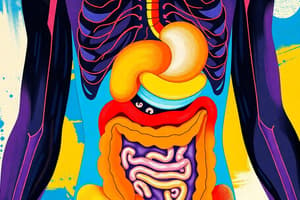Podcast
Questions and Answers
Apa peran empedu dalam sistem pencernaan?
Apa peran empedu dalam sistem pencernaan?
- Mengonversi lemak menjadi asam lemak (correct)
- Memproduksi hormon insulin
- Membantu mengurai karbohidrat
- Penyimpanan enzim pencernaan
Di bagian tubuh mana enzim amilase paling banyak berperan?
Di bagian tubuh mana enzim amilase paling banyak berperan?
- Jantung
- Lambung
- Pankreas (correct)
- Usus Besar
Apa fungsi utama usus besar dalam pencernaan?
Apa fungsi utama usus besar dalam pencernaan?
- Menyerap air dan elektrolit serta menghilangkan sisa makanan tak tercerna (correct)
- Menyerap nutrisi dari makanan
- Mengeluarkan empedu
- Membantu melarutkan gula
Apa yang dilakukan pankreas untuk membantu dalam pencernaan?
Apa yang dilakukan pankreas untuk membantu dalam pencernaan?
Apa yang dilakukan hati selain memproduksi empedu?
Apa yang dilakukan hati selain memproduksi empedu?
Di mana proses pencernaan dimulai?
Di mana proses pencernaan dimulai?
Apa fungsi lambung dalam sistem pencernaan?
Apa fungsi lambung dalam sistem pencernaan?
Apa yang terjadi di usus kecil yang membuatnya penting untuk penyerapan nutrisi?
Apa yang terjadi di usus kecil yang membuatnya penting untuk penyerapan nutrisi?
Apa yang menjadi peran utama esofagus dalam sistem pencernaan?
Apa yang menjadi peran utama esofagus dalam sistem pencernaan?
Apa enzim yang terlibat dalam pemecahan karbohidrat di mulut?
Apa enzim yang terlibat dalam pemecahan karbohidrat di mulut?
Flashcards are hidden until you start studying
Study Notes
Digestive System
The digestive system is responsible for breaking down food into nutrients so they can be absorbed by the body and used for energy and growth. It consists of several organs including the mouth, esophagus, stomach, small intestine, large intestine, liver, pancreas, and gallbladder. The process of digestion is complex and involves enzymes, acids, and other substances that help break down food into smaller parts that can be absorbed and utilized by the body.
Mouth
The process of digestion begins in the mouth where the mechanical and chemical breakdown starts with chewing. Saliva, which contains enzymes like salivary amylase, helps break down carbohydrates. The teeth help grind food, mixing it well with saliva for proper swallowing.
Esophagus
Food from the mouth travels through the esophagus, a muscular tube connecting the throat to the stomach. Swallowing reflexively moves food downwards with a wave-like movement called peristalsis.
Stomach
The stomach further breaks down food mechanically and chemically through mixing it with hydrochloric acid and enzymes like gastric lipase and proteases. It churns the mixture known as chyme, then slowly releases it into the small intestine.
Small Intestine
In the small intestine, most absorption occurs due to its large surface area and finger-like projections called villi and microvilli. Nutrients are absorbed into the bloodstream and transported to cells throughout the body. The stomach and pancreas produce digestive juices that enter the duodenum, the start of the small intestine, to aid in further breaking down food.
Large Intestine
The large intestine, consisting of the cecum, colon, rectum, and anal canal, absorbs water and electrolytes while eliminating undigested food particles as waste. The liver produces bile, stored in the gallbladder, which helps dissolve fats during digestion.
Liver and Gallbladder
The liver plays multiple roles in digestion. Besides producing bile, it detoxifies and metabolizes nutrients from digested foods. Enzymes in the liver convert carbohydrates into glucose, fats into fatty acids, and proteins into amino acids for building new tissues.
The gallbladder stores bile produced by the liver until it's needed to help break down dietary fats. When you eat, the gallbladder contracts and delivers bile to the small intestine where it mixes with the food.
Pancreas
The pancreas contributes to digestion by releasing digestive enzymes directly into the small intestine, particularly amylase for carbohydrates and trypsin and chymotrypsin for proteins. These enzymes help continue breaking down the digested food so it can be fully processed and utilized by the body.
Understanding the functioning of each part of the digestive system allows for better appreciation of how food becomes nourishment for our bodies.
Studying That Suits You
Use AI to generate personalized quizzes and flashcards to suit your learning preferences.




